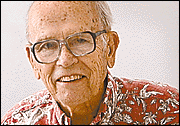


Hawaii’s World
PROPOSALS for Hawaiian sovereignty are so numerous and so diverse that most of us have a hard time sorting them out. Sorting out proposals for
Hawaiian sovereigntySenior Federal District Judge Samuel P. King, himself 3/16ths Hawaiian, has done the most complete overview of these proposals that I have yet seen. It appears in the Hawaii Bar Journal's July issue.
Looking at the sovereignty movement's gained momentum since 1970, King finds strong reasons justifying its vigor. He sees political, economic and religious/cultural emphases as areas where Hawaiians have significant grievances.
He notes the blood quantum contrast between the 50 percent required for the Hawaiian Homes program and the acceptance of Hawaiian blood down to the smallest fraction for participation in the Office of Hawaiian Affairs.
He highlights the diversity of proposals from advocacy of a breakaway nation independent of the U.S. to more modest but quite varied proposals of a state-within-a-state nature. For this, he draws from an overthrow anniversary videotape done in 1993 for Na Maka o ka Aina and Hui Naauao presenting 11 concepts of Hawaiian self-determination.
These include Kekuni Blaisdell's advocacy for complete independence, Frank Nobriga's Temple of Lono for a spiritual land bank of sacred places, the homestead-based concept of Kamaki Kanahele of the State Council of Hawaiian Homesteads, Ka Lahui Hawaii's advocacy of an independent sovereign community with a large land base, Dennis "Bumpy" Kanahele's already sovereign -- but small and thus nonthreatening -- community, the 1991 Legislature's creation of a Hawaiian Sovereignty Advisory Council with 12 organizations represented including OHA, and a separate OHA initiative to examine the provision of services to Hawaiians. (OHA is funding the second initiative, not the first.)
The Advisory Council now has become Ha Hawaii. It has staged an election and chosen delegates who will draft a Hawaiian constitution. It says their deliberations could last several years but it is short on funds.
King's final section asks, "What happens to the rest of the state and its citizens?" He contends there are sufficient public lands and income from these lands to meet the legitimate demands of Hawaiian sovereignty proponents without major disruption to the non-Hawaiian majority in our population.
His personal preferred solution would be built around the 50 percent Hawaiians who are eligible to be Hawaiian homesteaders.
HE comments: "They have the land base of homesteaded lands. They have the economic base of the farming and other commercial activity done on these lands. They have the numbers to be effective. They have the will and education to run their own lives. They are the most Hawaiian of the several organizations promoting Hawaiian welfare. They do not appear to be distracted by any historical emotional baggage."
He further notes they have been unified statewide since 1987 under the State Council of Hawaiian Homesteaders with a claimed membership of 30,000.
He says the homesteaders are uncomfortable with the word "sovereignty." They prefer "self-governance" and "self-determination," which they hope to accomplish by appropriate federal and state legislation.
"It's a way to go that will solve a lot of problems," King told me.
A.A. Smyser is the contributing editor
and former editor of the the Star-Bulletin
His column runs Tuesday and Thursday.